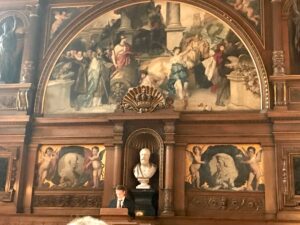Since April 1st, 2017 Prof. Dr. Bernhard Höfle is the new full professor for “GIScience and 3D Spatial Data Processing” at the Institute for Geography, Heidelberg University.
Last week he was formally introduced to the scientific community of Heidelberg University during the traditional “Professorium” event, which was moderated by Rector Prof. Eitel. The latter took place in the famous historic “Aula” of the so-called Old University (see picture below).
The establishment of a second full professorship in addition to the existing full professor in GIScience of Alexander Zipf is a great step forward for GIS-related science activities in Heidelberg and strengthens both research and teaching in Geoinformatics at the university and the whole region.
With a synergetic overlap the research interests and activities, as well as the teaching spectrum of Prof. Höfle complements and extends the existing GIS expertise in Heidelberg considerably. This leads to a broad and deep set of knowledge and activities in Heidelberg that opens further horizons for collaboration and research in an even more sustainable way.
The realisation of the new professorship is the result of remarkable achievements in terms of research outcomes – esp. during the previous time as “Junior-Professor” at Heidelberg University. This dedication and efforts paid off and is the most promising base for further success stories.
Prof. Höfle joined the GIScience Heidelberg Team as a team leader in 2010 and became Junior Professor there in 2011. A native Vorarlberger (Austria), he studied Geography in Innsbruck (Austria) and Uppsala (Sweden) and received his PhD (Dr. rer nat). from University of Innsbruck in 2007. Then he did his PostDoc at the Institute of Photogrammetry and Remote Sensing (IPF), Vienna University of Technology until 2009 and afterwards was Research Assistant at the Institute for Geoinformatics and Remote Sensing (IGF) at the University of Osnabrück, Germany until he came to Heidelberg.
During this time he very successfully developed a strong Lidar Research Group, conducted several research projects resulting in well cited publications and supervised several PhDs apart from many further activities in science organizations, teaching and administration.
The whole GIScience team congratulates cordially to this great step for both Prof. Höfle and Heidelberg and we are all looking forward to continue working together on most interesting challenges in GIScience.



